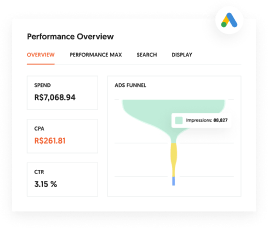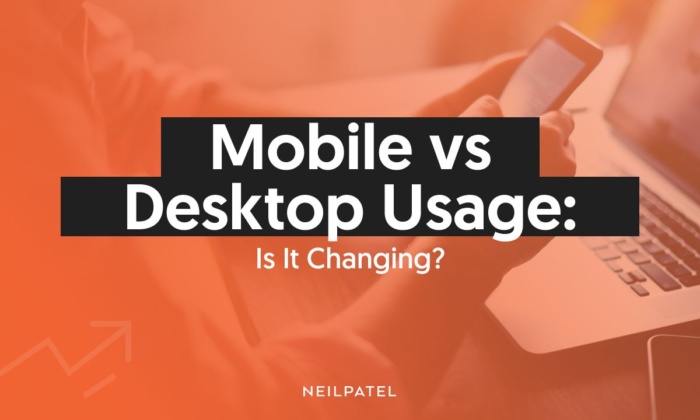
When is the last time you worried that you weren’t doing enough to optimize your website for your audience? If you’re a marketer, the odds are that it’s constantly on your mind. From SEO rankings to page speed to on-page content, we think about how search engines and users will interact with our website and what we can do to optimize those experiences.
But are you making research-backed decisions for your website based on which devices your users are primarily using?
The truth is there are a lot of assumptions about mobile users versus desktop users. For example, how they interact with websites, what they spend their time doing, and what will make them more likely to convert.
Assumptions aren’t facts, though.
Fortunately, website analytics tools like Ubersuggest make it possible for us to find out the truth.
So, before you go ahead and make assumptions about what devices your visitors are using and how they’re interacting with your site, consider the data we’ve outlined below.
What Is Assumed About Mobile Vs. Desktop Users
For marketers, there are a lot of assumptions made about mobile vs desktop users. Are those assumptions warranted?
First up, let’s look at mobile users.
According to the State of Mobile in 2022, more time than ever (4.8 hours per day) is being spent in mobile apps. That makes sense when we look at the mobile landscape in 2021, with mobile users downloading 435,000 apps per minute.
Mobile has continued to grow in share each year. As of September 2022, the worldwide split among mobile, desktop, and tablet users was 58.72%, 39.18%, and 2.1%, respectively. The numbers are slightly different from a U.S.-only perspective, with a breakdown of 46% mobile, 50% desktop, and 4% tablet.
What are mobile users spending time on, exactly?
Social media, unsurprisingly, is a big one with 80% of social media usage coming from mobile devices. That’s not the only mobile-heavy activity, though. Other activities with greater than 80% of mobile-only usage are couponing and checking the weather.
What about desktop users?
Desktop users spend more time visiting websites than their mobile counterparts. From banking to real estate to travel, desktop users perform more in-depth research than mobile users as a whole.
That’s not to say they’re sealing the deal on desktop, though.
According to Merchant Savvy’s Global Mobile report, 58% of all multi-device purchases use mobile to close the sale. So, whether they started on desktop or tablet, they’re ending up on a mobile device to make the purchase more than half of the time.
Beyond activities, though, it’s also important to note the different habits of mobile users and desktop users.
A few key metrics have major differences between mobile and desktop users. Namely, mobile vs desktop conversion rates which show that desktop users tend to visit more pages (3.95) than mobile (2.67) and tablet users (3.21). Other important metrics to consider include:
- Average time on site, on average, was 40% longer on desktop than mobile.
- Mobile has the highest bounce rate (52.11% globally) when compared to desktop and tablet.
- Desktop is still in the lead when it comes to conversions, with desktop at 3.7% and mobile at 2.2%.
With all this said, desktop versus mobile statistics are constantly changing, so it’s best to optimize for both mobile and desktop experiences.
We Analyzed Mobile Vs. Desktop Users
To gain a greater understanding of how device usage varies by industry, we’ve analyzed nine businesses across four industries – one cryptocurrency, one SaaS, four E-Commerce, and three B2B. When analyzing the websites, we focused on four main metrics:
- Mobile users (all traffic)
- Desktop users (all traffic)
- Mobile users (organic traffic)
- Desktop users (organic traffic)
For seven of the nine websites, we collected data over a 12-month period from September 2021 to September 2022. The other two time periods will be indicated when discussing results below.
Cryptocurrency: Mobile-Dominated
For the cryptocurrency website we analyzed, we used metrics from April 20th, 2022 through October 4th, 2022. Here’s what we found.
When looking at all traffic sources, 78.22% of traffic was mobile. This leaves 20.59% being from desktop traffic. As for organic traffic only, 63.92% was mobile, while the remaining was desktop.
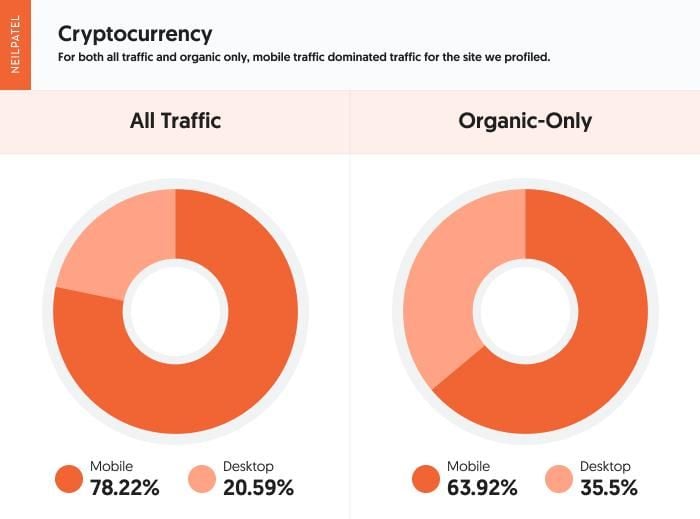
Software as a Service (SaaS): A Diverse Split
Software as a Service (SaaS) is a software licensing mobile, also known as “software on-demand.” Think of software services like Google Workspace and Salesforce.
Similar to the cryptocurrency example above, we focused on one SaaS website to analyze. Over a 12-month period, we see a very close division between mobile and desktop. That is, 50% mobile traffic and 50% desktop traffic. When it comes to organic-only traffic sources, we see a more distinct division of 25% mobile traffic and 75% desktop traffic.
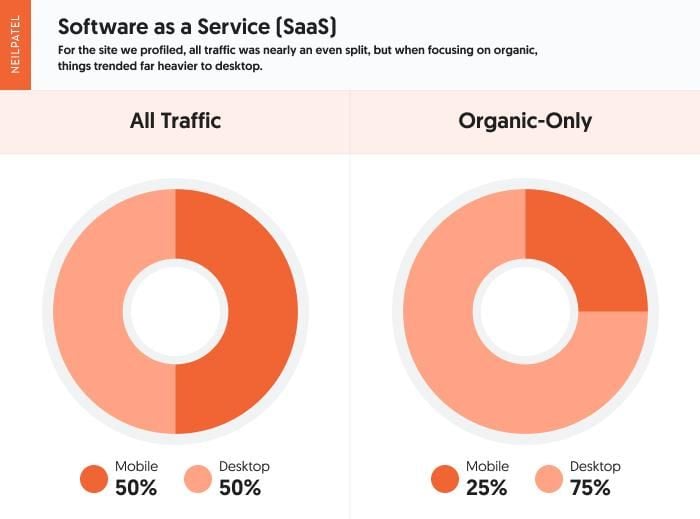
E-Commerce: Industry Matters
As marketers, we spend a lot of time thinking about optimizing our e-Commerce website. However, not all e-Commerce sites are created equal. Let’s consider the variations in the four e-Commerce businesses we analyzed.
For all traffic, mobile traffic varied from 55.13% to 80.64%. When looking at organic traffic only, the numbers shifted slightly from 54.56% to 76.23% mobile traffic.
If you consider what we know about e-Commerce, this variation makes sense.
First, e-Commerce is a highly diverse industry. From food to jewelry to clothing to home decor, there are e-Commerce businesses for just about anything you can buy. This appeals to all demographics, regardless of gender, age, location, and socioeconomic class.
With that diversity, we do see clear breakdowns across generational lines. For example, digital spending on mobile is highest in the video games industry, which has a larger younger user base, while jewelry and watches, a segment that skews older, is highest on desktop.
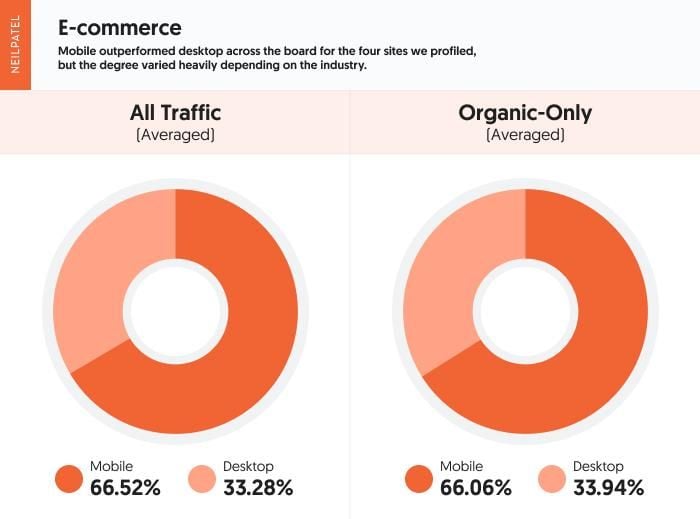
Business to Business (B2B): Meeting Your Audience Where They Are
The last industry we analyzed was B2B with four case examples.
For the B2B #1, we saw an extreme variation in mobile versus desktop usage. Mobile (all traffic) was at a measly 8.78%, with organic mobile faring worse at 7.17%.
On the other hand, B2B #2 and #3 saw very similar mobile traffic stats. B2B #2 had a mobile (all traffic) rate of 28.59% with an organic mobile rate of 23.7%. B2B #3 has similar numbers with 32.02% mobile (all traffic) and 27.37% mobile (organic).Lastly, B2B #4 has a split of 60% mobile, (all traffic) and 59% mobile (organic).
These variances aren’t uncommon in B2B, as B2B covers a wide range of industries and niches. From construction to telecommunications to healthcare, B2B offers a wide range of services and products which will attract an array of customers.
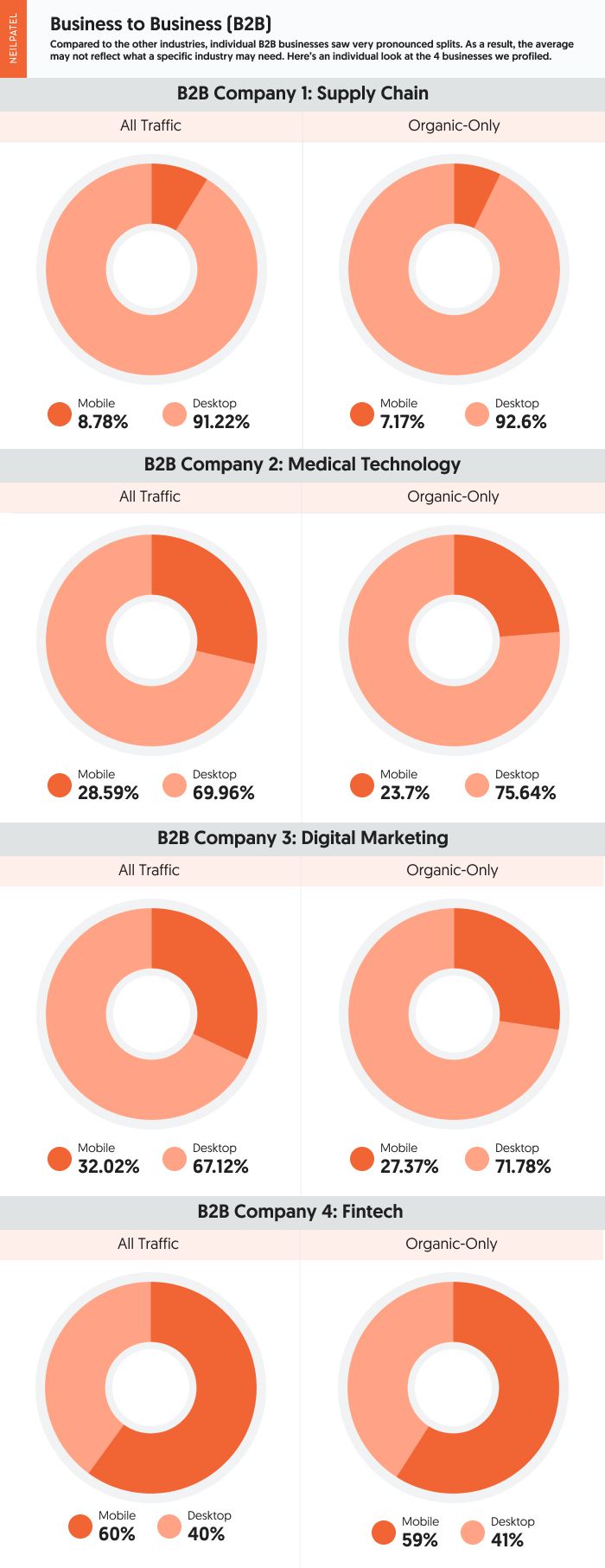
What We Learned From Our Data
Cryptocurrency, e-Commerce, and SaaS have the most mobile users. These industries are going to want to heavily prioritize mobile UX and optimize for mobile search. In practice, this may look like:
- Optimizing mobile page speeds
- Reducing the scrolls necessary to reach prioritized information
- Optimizing button sizes
- Prioritizing simple navigation
- Creating mobile-friendly content
Ultimately, the goal is to make the mobile experience as easy, fast, and frustration-free as possible.
The B2B websites we analyzed had more users coming to their site via desktop over mobile. That’s not too surprising, considering that most people will be researching and purchasing from B2B companies during office hours. They’re likely sitting at a desk with a desktop easily available.
We know that mobile-first indexing impacts rankings. This puts B2B websites in a unique position. They must optimize for mobile-first if they want to rank well, but they also have to prioritize desktop user experience.
This usually means more robust content, larger graphics, and more desktop-friendly user experience capabilities. However, load time on mobile is crucial from a ranking standpoint.
So, what’s the solution?
Focus on page speed optimization for both mobile and desktop. Page experience is a good place to start. You can also check out this ultimate SEO checklist for more ideas to implement.
Now, why are users going to SaaS, cryptocurrency, and e-Commerce websites with their mobile phones? Phones are portable and convenient. You can kill time with social media, find comparable products while perusing a brick-and-mortar store, or even check in on your stocks while standing in line at the supermarket.
On the opposite end of that is B2B. B2B businesses are targeting exactly that – other businesses. Whether on a desktop or laptop, employees will find it easier to research and place specialty orders on a desktop website.
Mobile vs. Desktop: Busting Myths
While it’s important to examine the present-day data on mobile versus desktop, it’s also crucial to understand the shift that’s taking place.
There are a lot of assumptions and myths about mobile versus desktop users.
For example, we mentioned that social media is a large part of what mobile users are spending their time doing. That doesn’t mean that these mobile users aren’t also making important consumer decisions.
A lot of these decisions come from their social media usage – whether because friends are recommending another brand or another brand targeted them more effectively with advertisements.
Similarly, we know that desktop users convert at a higher rate than mobile users. At the same time, more than half of cross-device users are researching on desktop but making the purchase on mobile. These two facts aren’t mutually exclusive.
So, what’s my point?
As marketers, we need to be wary of putting users in a box. These assumptions and myths will only limit us. In the end, we need to focus on optimizing the experience for both desktop users and mobile users so we can maximize our conversions.
FAQs
Do you have more questions on mobile versus desktop? Here are the answers to some frequently asked questions.
Which industry typically has more mobile users?
It’s not surprising that industries that target an array of demographics, or that target the younger demographic specifically, will see more mobile users. This includes cryptocurrency and E-Commerce.
Which industry typically has more desktop users?
Industries that target an older demographic, or those that target businesses specifically, are likely to see a higher concentration of desktop users.
Why should I focus on mobile first if most of my users use desktop?
Google rolled out mobile-first indexing in 2018. This means Google primarily uses the mobile version of your webpage for ranking and indexing purposes. As such, your website must be optimized for mobile users if you wish to rank well, even on desktop.
Does the type of device matter for my marketing strategy?
From channel (e.g., social media, email, paid advertising) to graphics to marketing content, the type of device that your target audience uses should play a huge role in your marketing strategy. For example, if you have a strong mobile audience, then social media marketing and mobile-friendly graphics should be a large part of your plan. If desktop is more common among your audience, then paid search advertising and more in-depth website copy is a safe bet.
Conclusion
Marketers take a lot of factors into consideration when optimizing their content, their marketing strategies, and their websites.
What’s the answer, then?
You need to optimize and improve your website performance for both mobile users and desktop users. As device usage statistics continue to shift, it’s best to cater to both sides of your audience.
What initial steps will you take to optimize your website while accounting for your audience’s device usage breakdown?

See How My Agency Can Drive More Traffic to Your Website
- SEO - unlock more SEO traffic. See real results.
- Content Marketing - our team creates epic content that will get shared, get links, and attract traffic.
- Paid Media - effective paid strategies with clear ROI.
Are You Using Google Ads? Try Our FREE Ads Grader!
Stop wasting money and unlock the hidden potential of your advertising.
- Discover the power of intentional advertising.
- Reach your ideal target audience.
- Maximize ad spend efficiency.

